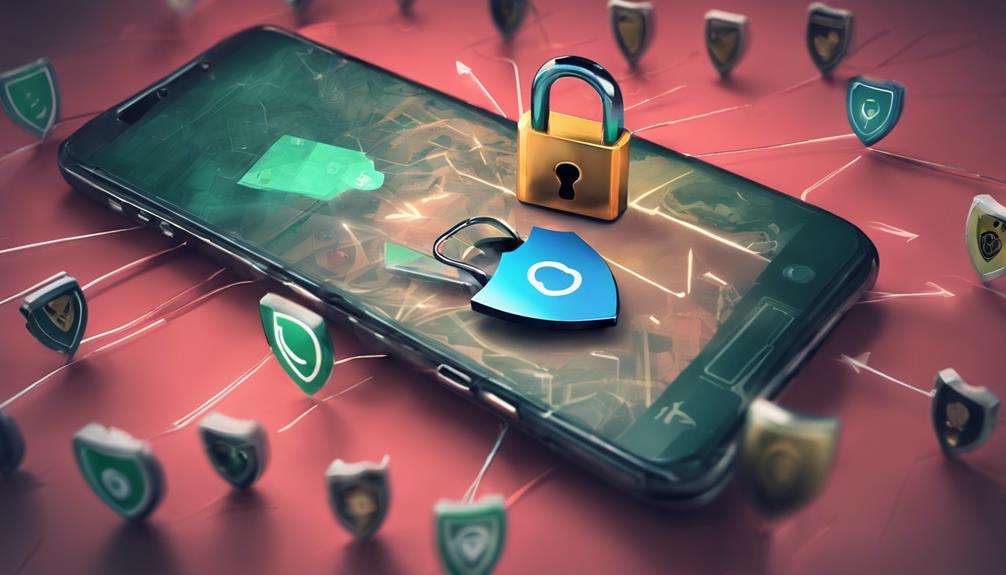WhatsApp on Android is fortified against hackers due to robust security measures. These include end-to-end encryption, regular app updates, two-step verification, cautious message handling, and mobile security software employment. The end-to-end encryption guarantees communication confidentiality and trust, while app updates patch vulnerabilities. Two-step verification adds an extra layer of protection, deterring unauthorized access. Careful handling of messages and suspicious content avoidance also play key roles in maintaining security. By following these practices, users can establish a secure environment for communication on WhatsApp.
Key Takeaways
- End-to-end encryption protects messages from hackers.
- Regular app updates patch security vulnerabilities.
- Two-step verification adds an extra layer of security.
- Exercise caution with messages to avoid hacking attempts.
- Utilize mobile security software for malware protection.
Overview of WhatsApp Security Measures
In safeguarding user privacy and data integrity, WhatsApp employs a range of security measures on its Android platform. These measures include end-to-end encryption, which guarantees that messages are securely transmitted and can only be accessed by the sender and recipient.
Additionally, WhatsApp offers two-step verification, adding an extra layer of protection to prevent unauthorized access to accounts.
Regularly updating WhatsApp on Android is important as it helps to patch security vulnerabilities and makes sure that the latest security features are in place. Users are advised to exercise caution by avoiding clicking on suspicious links or sharing personal information that could compromise their security.
Moreover, enabling security notifications can alert users to any suspicious login attempts on WhatsApp, allowing them to take immediate action to secure their accounts.
Understanding End-to-End Encryption

End-to-end encryption in messaging is an essential element for ensuring the privacy and security of communications.
By utilizing encryption keys to encode and decode messages, WhatsApp protects user data from unauthorized access, including from the platform itself.
This sophisticated encryption technology not only prevents hackers from intercepting messages but also adds a layer of trust and confidentiality to the communication process.
Encryption in Messaging
Utilizing robust encryption protocols in messaging applications is essential for safeguarding sensitive data and ensuring secure communication channels. When it comes to messaging apps like WhatsApp, end-to-end encryption plays a vital role in protecting user information from potential security breaches by hackers on Android.
Here are three key aspects to take into account regarding encryption in messaging:
- WhatsApp's End-to-End Encryption: WhatsApp employs end-to-end encryption to secure messages, calls, and media shared between users. This encryption method ensures that only the sender and recipient have access to the content, making it challenging for hackers to intercept and decipher the messages.
- Unreadable Encrypted Messages: Even if encrypted messages are intercepted during transmission, they remain unreadable to hackers without the decryption keys. This added layer of security helps in preserving the confidentiality of the communication within the WhatsApp platform.
- Two-Step Verification: To further enhance security, WhatsApp offers two-step verification, requiring a code in addition to the usual login credentials. This extra step helps prevent unauthorized access to users' accounts, adding an additional barrier against potential security threats.
Privacy and Security
WhatsApp's implementation of end-to-end encryption on Android guarantees a high level of privacy and security for user communications. This security feature confirms that messages, calls, and photos are end-to-end encrypted, meaning only the sender and recipient can access the content.
With this encryption protocol in place, hackers are unable to intercept or decrypt messages sent through WhatsApp, safeguarding user privacy. Additionally, Android users can enhance their security by enabling two-step verification, adding an extra layer of protection against potential hacking risks.
Importance of Regular App Updates

Regular app updates on Android devices play a critical role in enhancing the security of WhatsApp. By updating the app regularly, users can guarantee that any vulnerabilities present in older versions are patched promptly, safeguarding their personal information.
Hackers often exploit weaknesses in outdated apps, making it imperative for Android users to stay vigilant and prioritize updating their WhatsApp for a secure communication experience.
Update for Security
Consistent updating of the WhatsApp application on your Android device is paramount for enhancing security measures against potential cyber threats. Regular updates for WhatsApp often include critical patches for vulnerabilities that hackers may exploit to gain unauthorized access to your device.
By keeping the app up to date, you are actively protecting your personal information and data from potential hacking attempts that could compromise your privacy and security. To guarantee you are always running the latest, most secure version of the app, Android users can enable automatic updates for WhatsApp.
Ignoring these updates may leave your device vulnerable to various hacking techniques employed by cybercriminals who specifically target WhatsApp users. Therefore, staying vigilant and proactive in updating your WhatsApp regularly is essential in safeguarding your device and personal information from malicious threats.
Vulnerabilities in Older Versions
Maintaining the security of your Android device necessitates timely updates for the WhatsApp application to mitigate vulnerabilities present in older versions. Hackers often target these outdated versions to exploit security flaws and gain unauthorized access to user data. By keeping your WhatsApp app up to date, you can notably reduce the risk of falling victim to such unauthorized access attempts on your Android device.
| Vulnerabilities in Older Versions | ||
|---|---|---|
| Vulnerabilities present | Hackers exploit | Unauthorized access |
| Security flaws | Outdated versions | User data |
| Timely updates needed | Potential risks | Mitigate threats |
Regularly updating your WhatsApp app is not just a recommendation; it is a critical step in safeguarding your personal information from cyber threats. By understanding the importance of staying current with app updates, you can actively protect your data and privacy from malicious actors seeking to exploit vulnerabilities in older versions.
Patching App Weaknesses
To enhance the security of your Android device and protect your data, ensuring timely updates for the WhatsApp application is vital in patching app weaknesses. Regular app updates play a significant role in maintaining the security of WhatsApp on Android devices, safeguarding against potential hacking threats and vulnerabilities.
Here are three reasons why staying up-to-date with WhatsApp updates is imperative:
- Security Enhancements: Updating WhatsApp on your Android device ensures that any known security vulnerabilities or weaknesses are patched, reducing the risk of unauthorized access or data breaches.
- Protection Against Hacking: Hackers often target outdated versions of apps like WhatsApp to exploit known vulnerabilities. By updating the application regularly, you fortify your device against hacking attempts and malicious activities.
- Mitigating New Threats: With the evolving landscape of cybersecurity threats, updating WhatsApp on Android helps protect your device from emerging hacking techniques and security risks, keeping your data safe and secure.
Two-Step Verification for Enhanced Security

For essential security on your Android device, consider enabling two-step verification on WhatsApp. Two-step verification adds an extra layer of protection to your account by requiring a code in addition to your password.
This security feature is vital, especially on Android devices, as it helps prevent unauthorized access even if your password is compromised. Setting up two-step verification is simple and can be done easily within the WhatsApp app settings.
It is highly recommended for all Android users to enable this feature to safeguard their accounts from potential hackers. By incorporating two-step verification, you not only enhance the security of your WhatsApp account but also safeguard that your personal information and conversations remain protected.
Take the necessary steps to keep your device secure and your WhatsApp account safe from any unauthorized access.
Identifying and Avoiding Suspicious Messages

When moving through WhatsApp messages, users should exercise caution and vigilance to identify and steer clear of suspicious communication. Here are three essential tips to help users recognize and avoid potentially harmful messages:
- Be wary of requests for personal information: If a message from an unknown contact asks for personal details or verification codes, it's important to refrain from sharing such information. Scammers often use these tactics to gain access to private data, compromising your privacy and security.
- Avoid clicking on suspicious links: Links sent through WhatsApp messages should be approached with caution. Clicking on unfamiliar or suspicious links can lead to malware installation or phishing attacks, potentially putting your phone and data at risk.
- Report and block suspicious messages: In case you encounter messages with spelling or grammar errors, or messages that seem unsolicited or unusual, it's advisable to report and block the sender. Taking this action promptly can prevent unauthorized access attempts and safeguard your messaging privacy.
Utilizing Mobile Security Software

Effective utilization of mobile security software plays an important role in safeguarding Android devices against various cyber threats, such as malware, spyware, and phishing attempts. When considering the safety of using WhatsApp, implementing the latest security measures is essential to protect users from potential risks.
Mobile security apps offer features like real-time scanning and safe browsing, which can prevent hackers from installing malware on users' devices through malicious links or files shared on the platform. To enhance security while using WhatsApp, it is advisable to regularly update the mobile security software on your device. Additionally, enabling two-step verification within the app can add an extra layer of protection to maintain the confidentiality of user data.
Safeguarding Personal Information

Utilizing proper security measures, such as enabling two-step verification, is imperative for safeguarding personal information while using WhatsApp on Android devices.
To enhance the protection of your WhatsApp account and personal data, consider the following:
- Enable Two-Step Verification: This additional layer of security requires a unique code, along with your password, to access your WhatsApp account, greatly reducing the risk of unauthorized access.
- Avoid Sharing Private Photos: Refrain from sending sensitive or private photos through WhatsApp to prevent potential privacy breaches. Consider using more secure methods for sharing such content.
- Stay Vigilant Against Phishing Scams: Be cautious of messages or links from unknown contacts requesting personal information. Phishing scams are prevalent, aiming to trick users into revealing sensitive data that could compromise account security.
Frequently Asked Questions
Are There Any Dangers in Using Whatsapp?
While WhatsApp is a popular messaging platform, there are potential dangers associated with its use, such as phishing attacks and unauthorized access. Users should employ security measures like two-step verification and avoid sharing sensitive information to mitigate risks.
Can Someone See My Whatsapp Messages From Another Phone?
Messages on WhatsApp are end-to-end encrypted, ensuring they can't be accessed from another phone. Verification codes and two-step verification enhance security. Avoid sharing sensitive information and regularly monitor your account for unauthorized access.
Can Hackers Read Whatsapp Messages?
Hackers cannot read WhatsApp messages due to end-to-end encryption, ensuring only the sender and recipient have access. Two-step verification adds security. Strong passwords and regular updates protect messages. WhatsApp is safe from hacking attempts.
Why Would Someone Use Whatsapp Instead of Texting?
WhatsApp provides a versatile platform for communication with features like group chats, voice calls, and file sharing. Its encryption guarantees privacy, while two-step verification enhances security. The convenience, global reach, and cost-effectiveness make WhatsApp a preferred choice over traditional texting.
Conclusion
In the domain of cybersecurity, WhatsApp's security measures serve as a shield against potential threats, safeguarding user data through encryption, regular updates, and two-step verification.
By remaining vigilant and cautious in identifying suspicious messages and utilizing mobile security software, users can further fortify their defenses against hackers.
Ultimately, in the digital landscape, ensuring the safety of personal information is paramount, akin to protecting a precious treasure from lurking dangers in the shadows.









